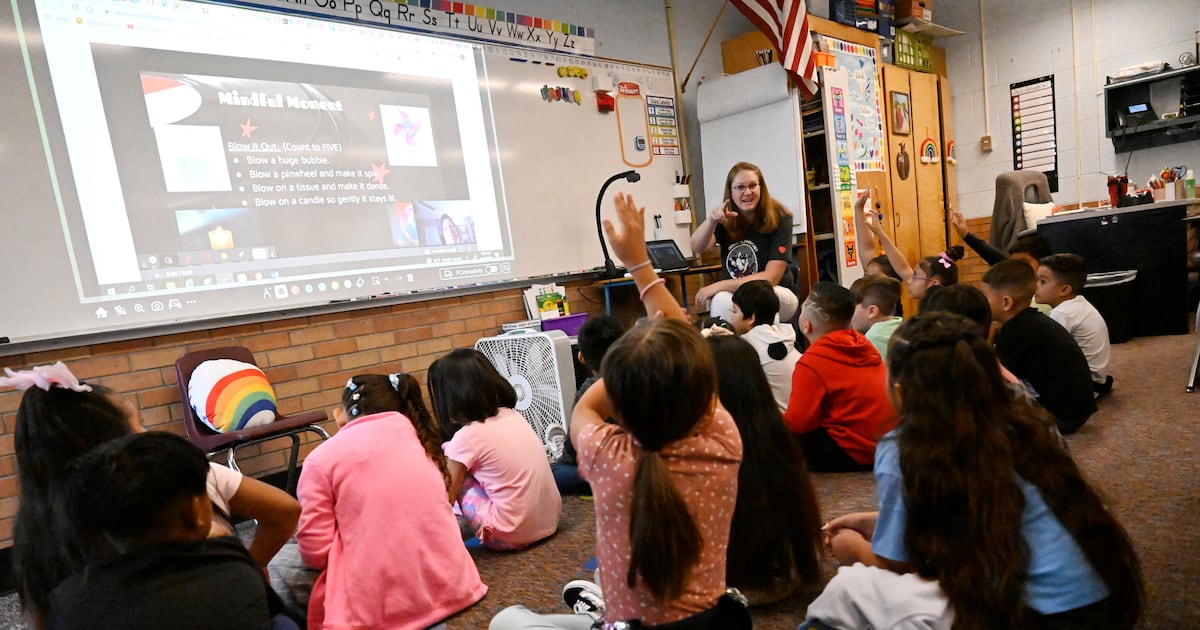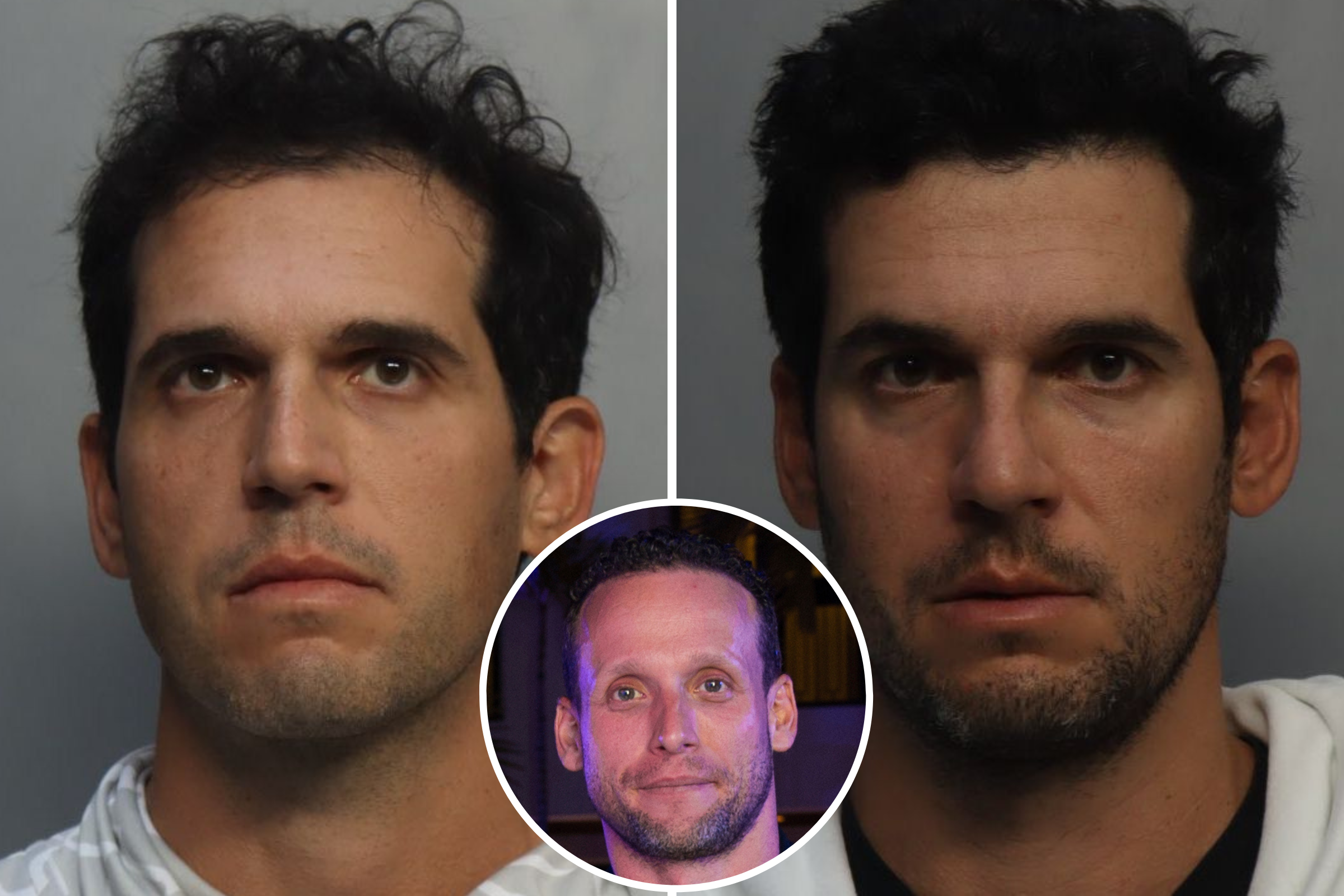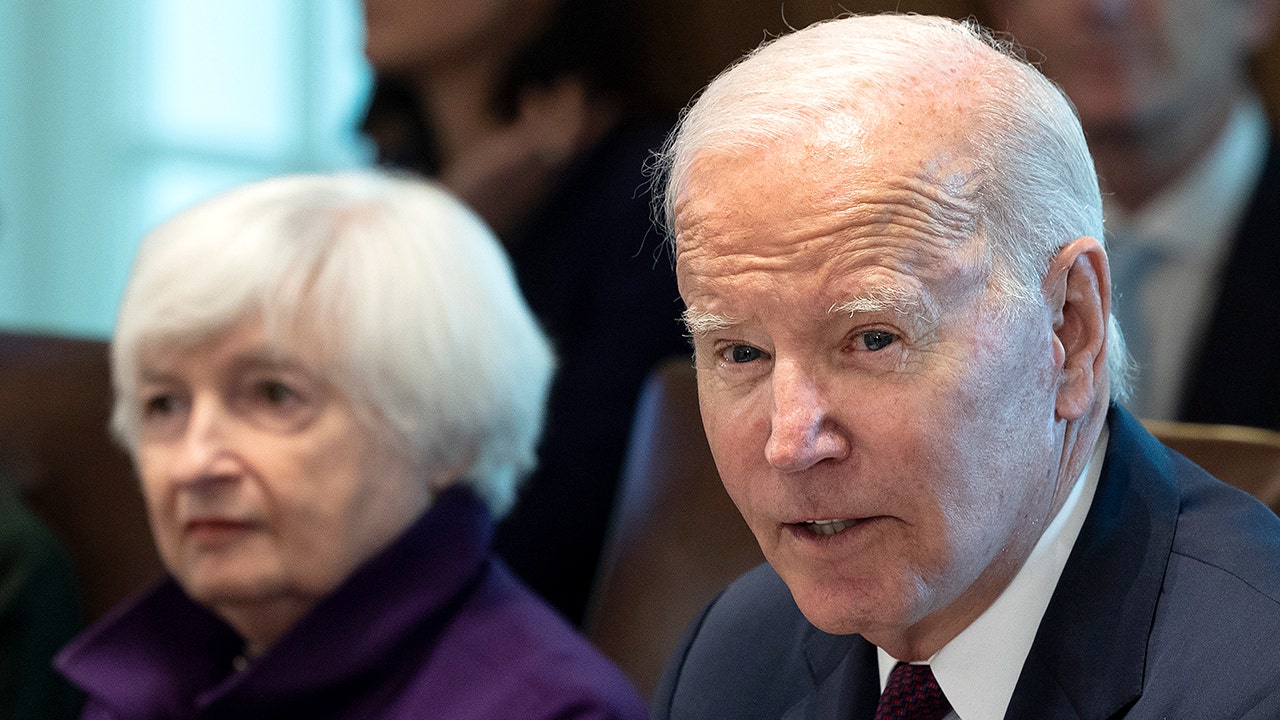Colorado
Orphaned bear cubs released in western Colorado

A Colorado wild animal rehabilitation organization released photos after two bear cubs were released to their original habitat last week. After their mother was struck and killed in a car crash near Paonia, the cubs spent the summer and fall at the Frisco Creek Wildlife Rehabilitation Center bulking up and socializing with other cubs.
Authorities said the bear cubs reached 80 pounds and were ready to den. Animal experts took them back to their original home last week to find a den for the winter. The cubs have enough fat to get through the winter, said the FCWRC, and will have a headstart when they come out of hibernation next spring.
The hope is that the cubs will reproduce with other members of the bear population and avoid conflict.

Colorado
Some Colorado districts are expecting to see a cut in the number of at-risk students this year

Sign up for Chalkbeat Colorado’s free daily newsletter to get the latest reporting from us, plus curated news from other Colorado outlets, delivered to your inbox.
This fall, fewer students at some Colorado schools are being counted as at-risk because pandemic-era rules for Medicaid left many families suddenly unenrolled by spring 2024.
Students enrolled in Medicaid are automatically counted as at-risk students in calculations about funding. A drop in the number of at-risk students can cause some schools to lose federal Title I funding used to help those students, who generally have higher educational or social-emotional needs.
The Jeffco district, the second largest in Colorado, told its school board last month that 6,000 of the district’s approximately 75,600 students were unenrolled from Medicaid.
At some schools, the decrease in at-risk students may be enough to drop a school below the required threshold to receive Title I money. Currently in Jeffco, that threshold is 55%, but may change for next year.
Title I funding varies between schools and districts, but in Jeffco, on average schools get about $900 extra for each at-risk student. The money is used to hire additional staff and provide extra resources.
Some families are worried that their children’s schools could lose that funding. Edgewater Elementary School parent Angela Cryan took her concerns to the Jeffco school board last month.
“We are so concerned, and the families that are here tonight with me are so concerned, about losing the funding that is critical even for one year,” Cryan told school board members and the superintendent. “Whatever that amount is, it is too much to lose for our students.”
Superintendent Tracy Dorland told Cryan not to fear. Dorland said Edgewater Elementary would still qualify for Title I funds next school year.
District officials have refused to share school-level data, saying that everything is still being reviewed for accuracy. Official enrollment demographic data is usually published by the state in January.
For students who were unenrolled or those who aren’t eligible for Medicaid, including students from families that may not have legal status, parents can still fill out free and reduced-price lunch forms and, if eligible, be counted in at-risk figures that way.
The district has shared the number of students who qualify for free or reduced-price meals. The figures are usually similar to at-risk numbers. At-risk counts include all students who are eligible to receive subsidized meals, but also other students including those who receive Medicaid. Overall, the district projects the percentage of students eligible for subsidized meals will be 31% this school year, down from 34% last school year.
The trend of having fewer students eligible for subsidized meals, and fewer at-risk students, is not unexpected, Jeffco leaders told the school board.
“That’s actually about what we thought was going to happen over time,” said Brenna Copeland, chief financial officer for Jeffco Public Schools. “The reality is the counts district-wide are going down, and that’s going to impact, over time, our Title I district-wide.”
Kym LeBlanc-Esparza, deputy superintendent in Jeffco, said the district has not set the percentage threshold that determines which schools will get Title I funding next year.
“We’re still going back and forth, making sure we have exactly what those numbers are,” she said.
Title I trends were worrying districts before the pandemic
Before the pandemic, districts were having to adjust the bar for which schools receive Title I status. Despite declining enrollment and overall stable numbers of students from low-income families, the distribution of those students was not even within districts. Students from high-poverty households tended to be concentrated in select schools. That meant that more schools were more likely to hit the thresholds of 65, 70, or 75% of students in poverty, for example, to qualify for the funding.
More schools qualifying for Title I status in a district can be a problem, because it doesn’t necessarily mean the district is receiving more federal funding for those schools. The federal government has a different calculation based on census data for determining how much funding to send districts.
That data doesn’t take into account school choice laws that allow Colorado students to attend schools outside their neighborhoods, changing the demographic makeup of students at schools when compared to their community.
Districts also have flexibility to determine which schools will receive the money. They specify the percentage of at-risk students schools must have to be considered Title I.
In Jeffco, that bar is currently set at 55%, and this year, 31 schools are receiving Title I funding.
Pandemic-related demographic changes and the state’s 2023 decision to use Medicaid eligibility to determine the number of at-risk students in a school initially made the numbers rise, but those numbers could decrease now in districts like Jeffco and Adams 12.
Jeffco leaders wouldn’t say how many schools could lose the funding if the current threshold of 55% was used for next year. Officials are deciding whether or not to change it.
If the decision causes some schools to lose eligibility, the district can do a phase out so that schools don’t immediately lose the funding when their demographics change, LeBlanc-Esparza said.
In Adams 12, Gina Lanier, the district’s chief financial officer, said the district is seeing a drop of about 3,900 students who qualify as at-risk based on Medicaid eligibility. Last year, about 50% of the district’s nearly 35,000 students qualified for subsidized meals, meaning they were counted as at-risk students.
Overall, Lanier predicts the number of students who qualify for free meals in Adams 12 will have dropped this school year by more than 6%.
Lanier said if Adams 12 keeps the thresholds it currently has for Title I eligibility, five schools will no longer qualify for the funding next school year.
As budget planning gets underway, Lanier said the district will discuss whether to change those thresholds or create a plan to support schools that would lose funding so that it’s phased out instead of immediately going to zero.
In the Aurora school district, leaders have pushed the threshold for how many at-risk students a school must have to receive Title I to the federal government’s maximum allowed limit of 75%. The district had 14 new schools qualify last year and is now at 31.
But Aurora, and other metro area school districts, said they’re not expecting declines in the number of schools qualifying for Title I status.
How one Jeffco school uses Title I funding
Although Title I money is important, it’s not the only source of extra funding for schools with lots of at-risk students. Many districts also direct state and local dollars to these schools.
In Jeffco, for example, the district money given to schools for at-risk students is significantly more than what the schools get for having Title I status. The money is given on a per-student basis regardless of whether a school meets a threshold, which can make the total funding amount less likely to change by large amounts from one year to the next.
Principal Megan Martinez of Deane Elementary in Jeffco said her school in Lakewood has had Title I status for several years, and that the funding is helpful in supporting the needs of her students.
Enrollment at Deane this fall is up compared to what was expected, and Martinez is seeing a major increase in the number of students who are learning English as a new language. Many of the new students are newcomers and English learners.
The percentage of students qualifying for free or reduced-price meals appears to be holding steady. Last year, about 82% of Deane’s nearly 300 students qualified for subsidized meals. Martinez said the school helps families fill out the free lunch applications and explains other available benefits.
At Deane, Martinez said she uses the Title I funding primarily to hire teachers to keep class sizes small, or to avoid having to do combined-grade classrooms. The funding also pays for a restorative practice liaison, two interventionists helping teachers work on reading and math instruction, and supplements the school’s mental health resources.
This year, that means that in addition to the full-time social worker paid for by the district based on the number of students who have special needs, Deane’s Title I funds pay for an additional social worker to come in at least two days per week.
“They might support with setting lessons around behavior expectations, they might pull a friendship group or lunch bunch or another targeted group working on relationship skills, or do crisis response,” Martinez said. “We wouldn’t be able to do that without Title funding.”
Yesenia Robles is a reporter for Chalkbeat Colorado covering K-12 school districts and multilingual education. Contact Yesenia at yrobles@chalkbeat.org.
Colorado
Hunting groups sue Colorado wildlife commissioners over mountain lion hunting op-ed ahead of election

Two influential hunting organizations are suing members of the Colorado Parks and Wildlife Commission saying they violated Colorado Open Meetings Law and spread false information about mountain lion hunting prior to last month’s vote on Proposition 127, which would have banned the hunting and trapping of mountain lions, lynx and bobcats.
When the proposition failed by a margin of less than 5 percentage points, it marked the first time since 1992 that Colorado voters rejected a wildlife ballot proposal and stirred hope among some of a bridging of Colorado’s urban-rural divide.
But Safari Club International and The Sportsmens Alliance Foundation sued commissioners Jessica Beaulieu and Jack Murphy as well as former commissioner James Pribyl in Denver County Court over an opinion piece published in The Durango Herald on Oct. 12, supporting the proposition.
Beaulieu and Murphy both represent outdoor recreation and parks utilization on the commission.
The piece criticized lion hunting as a “highly unpopular, unscientific and unwarranted abuse and exploitation” of wildlife that “in no way contributes” to the “bright future of ethical outdoor recreation” in Colorado.
It also called out “a small lion-hunting industry” that guarantees 100% trophy lion harvest, the needless killing of female lions, and CPW itself, for offering cougar hunting “to serve mountain lion hunters alone, for a recreational opportunity.”
The Safari Club and the Sportsmen’s Alliance are alleging Beaulieu and Murphy violated Colorado’s Open Meetings Law because the column was written while the commission was actively considering a revised mountain lion management plan for the Eastern Slope. The management plan passed unanimously Nov. 15 after extensive public comment opposing the plan.
The lawsuit also alleges Murphy and Beaulieu had to have discussed writing the column that “flatly — and falsely — criticized Colorado’s current mountain lion and bobcat management programs” outside of a public meeting.
“But the hunting of mountain lions and bobcats is ‘public business’ under the Open Meetings Law,” the lawsuit alleges, and “the CPW Commissioners had these discussions without appropriate public notice and opportunity to participate.”
And the plaintiffs, calling the op-ed itself “a meeting under the Open Meetings Law,” say it harmed them because it put “false information into the public discourse.”
The organizations are asking the court to find Murphy and Beaulieu violated the law and to prohibit them from doing it again.
Neither hunting group responded to requests for comment.
“Commissioners can speak as private citizens”
In an Oct. 24 email to The Colorado Sun after the op-ed was published, CPW spokesperson Travis Duncan said the commissioners had not broken any laws.
“Voting Commissioners are not DNR employees, they are unpaid volunteers, so they do not fall under DNR’s HR personnel rules,” he wrote. “As the Commissioners were speaking as private citizens, this subject was not before the commission as an item of business and no open meeting law violation occurred.”
Jeff Roberts, executive director of the Colorado Freedom of Information Coalition, said that although the open meetings law says a meeting is open when two or more members of a state public body discuss public business, Colorado courts say there must be a demonstrated link between the content of a meeting and the public body’s policy-making responsibilities.
So because commissioners are not involved in deciding whether hunting of mountain lions and bobcats should be prohibited, he said, there was no link between the commissioners’ opinions in the op-ed and the commissions’ work.
A paper published by the Knight First Amendment Institute at Columbia University in October, argues that “accepting a government office — including an elected or appointed position — does not divest a speaker of all First Amendment rights.”
But Dan Gates, executive director of Coloradans for Responsible Wildlife Management, believes the plaintiffs are justified in suing the commissioners.
In an email to The Sun, he said Coloradans for Responsible Wildlife Management hopes “all appointed individuals adhere to the requirements of public process and procedures and protocols” because “while having a personal opinion is one thing, how one conveys or represents that opinion or how it was worked on with others, might be another matter.”
Beaulieu and Murphy told the commission they had no part in the letter writing during opening remarks at the Nov. 14 meeting.
“At no point did I communicate with commissioner Murphy about writing the op-ed or pending commission business, including the East Slope Mountain Lion Plan,” Beaulieu said.
“There was no collusion. We simply signed off on a letter. We did not talk about it at all. Not one single word was written by either one of us,” Murphy added.
Pribyl and advocates drafted the letter
Ellen Stein, opinion editor at The Durango Herald, said the letter came via email from Julie Marshall, public relations director for Animal Wellness Action, the group behind Proposition 127.
Marshall told The Sun Pribyl, the former commissioner, “and experts from the campaign” wrote the letter after which Beaulieu and Murphy were each sent drafts.
“Jess got a copy to see if she agreed in substance and wanted to add her name,” Marshall said. “Jack also got a copy separately and was offered the same thing to sign on. No seated commissioners met together ever. No seated commissioners were ever on the same email ever. They acted entirely alone in their own capacity as citizens. There is nothing nefarious or illegal here.”
“Safari Club is engaging in lawfare to attack on baseless grounds and chill speech because of the substance of the issue alone,” she added. “That is anti-democratic.”
Commissioner Marie Haskett, who represents sportspersons and outfitters, submitted her own letter to the editor in the Rio Blanco Herald Times on Oct. 10 urging a no vote on Prop. 127.
Colorado Sun reporter Jason Blevins contributed to this report.
Colorado
Why are so many iconic Colorado Springs restaurants closing down?

COLORADO SPRINGS, Colo. (KRDO) – Multiple eateries that have been staples of the Colorado Springs community are closing their doors for good, if they haven’t already.
Mountain Shadows Restaurant in Old Colorado City just announced they are closing and will be selling their building.
Cy’s Drive-in on the west side closed in October. The owner said the landlord decided she needed to be out by the end of the year.
Munchies 719 in Downtown Colorado Springs will close its doors for good at the end of the year. The owners told KRDO13 that they’re seeing fewer people around downtown. Numbers from the Downtown Business Association back up this claim and show there was a 1.61% downturn in foot traffic downtown since 2023.
KRDO NewsChannel 13 is committed to providing a forum for civil and constructive conversation.
Please keep your comments respectful and relevant. You can review our Community Guidelines by clicking here
If you would like to share a story idea, please submit it here.
-

 News1 week ago
News1 week agoRassemblement National’s Jordan Bardella threatens to bring down French government
-
World1 week ago
Freedom is permanent for Missourian described as the longest-held wrongly incarcerated woman in US
-

 Technology4 days ago
Technology4 days agoStruggling to hear TV dialogue? Try these simple fixes
-

 Business2 days ago
Business2 days agoOpenAI's controversial Sora is finally launching today. Will it truly disrupt Hollywood?
-

 World1 week ago
World1 week agoBrussels denies knowledge of Reynders's alleged money laundering
-

 Science1 week ago
Science1 week agoAll raw milk from Fresno dairy farm will be cleared from store shelves; cows have bird flu
-

 News1 week ago
News1 week agoRead Representative Jerrold Nadler’s Letter
-

 Politics1 week ago
Politics1 week agoOklahoma measure seeks to make school district superintendents an elected position
















